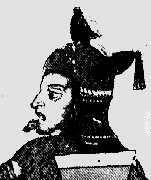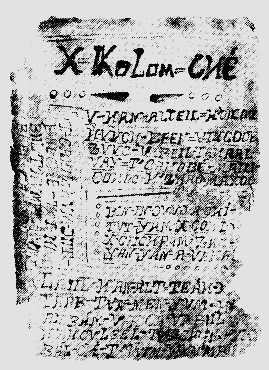

|
 |
|
 |
|

|
The Spanish Conquistadors quickly abolished the ancient writing and recording systems in Middle, Central and South America. However, many of the literate Native people there quickly learned the European alphabet and wrote down some of their classic literature in it, aided in some instances by sympathetic Spaniards. Early manuscripts have come down to us today written in Aztec (Nahuatl), in the Mayance languages, and in Quechua (Runasimi). These give us a glimpse of what has been lost or has not yet surfaced. Most of the pre-invasion works are anonymous, but several poets and authors have emerged from the ashes to claim their rightful places in the American literary tradition.
The Northern Nations primarily recorded their history and culture in the oral tradition but sometimes used pictographs and ideographs as mnemonic aids, similar to the way the Incas used quipus. Algonkin, Iroquois and Dakota all shared elements of the same pictographic system. The Wallum Olum, creation song of the Lenape (Delaware), has come down to us in parallel pictographs and alphabetic Lenape, a North American Rosetta stone.
These early manuscripts of ancient literature are a hidden part of our heritage; very few students of poetry in the USA know the names or existence of some of the earliest American poets. These translations and biographies are one attempt to help correct that. Reclaiming our multi-cultural heritage deepens our understanding of who we are and where our society is going.
There is only the thinnest line between song and poetry. In the Native American tradition one might say that there has not been any line between the two at all until recent times, and even now it is questionable.
All of these poem-songs are well over 500 years old, or at least parts of them are. It is not possible to confidently separate the original poems from their later transcriptions. The Flower Songs of Hungry Coyote and the Songs of Dzitbalche, are sometimes traditional, ceremonial and ritual, and at other times speak of personal feelings and ideas. The Sacred Hymns of Pachacutec are entirely ceremonial.
All were meant to be accompanied by music. The Aztec poems keep close to the rhythms and patterns of Náhuatl speech; they were performed to a distinct open-hand cadence on the huehuétl drum. It is not known if the Mayan lyrics, written in couplets, were spoken or sung. The Quechua poems were sung.
HOW I BECAME A TRANSLATOR The first Native language I studied was Navajo (Diné), in 1970, when I was working at the Cañoncito Navajo Reservation, east of Albuquerque. My job involved speaking to the older people, many of whom did not speak English, so I hired Alice Werito as my interpretor. She and I drove all over the reservation in a four-wheel drive pickup, visiting people, and in the process she helped me learn a little Diné.
Much earlier, way back in grammar school, I made the painful discovery that the English I'd learned at home was not adequate for school, so I had to learn English again almost as a second language. In the process I also became interested in languages. In high school and college I studied Spanish, French and Latin. I spent some time in Europe.
So when I started working with the Diné People, it seemed only natural to try to learn a little of their language. Of course I realized that very few non-Natives have ever become fluent in Navajo, one of the more difficult languages in the world, so fluency in Navajo was not my goal. But from studying other tongues I comprehended that language is the best doorway into understanding any other culture, and I wanted to try to understand the Dinés and to be able to exchange proper social formalities with them. My goal was just to get my toes wet in the language, not to master it. I got ahold of a book and tape set called Navajo Made Easier (Young and Morgan) and each day as I drove thirty miles to the reservation, I played the tapes over and over. Then as we drove around the reservation, Alice gave me lessons. That's how I came to learn a little Navajo.
So when I became interested in the Middle-American civilizations, it was only natural to me to want to study their languages a little.
In Yucatán I picked up a Yucatec Maya dictionary and grammer (Závala and Medina) and the Songs of Dzitbalché. In Mexico City I found the excellent Diccionario de elementos del Maya Yucateco Colonial (Swadesh), was introduced to Mariano Leyva and Martha Ramirez of the Universidad Nahuatl, bought Introduccion al estudio del idioma Nauatl by Jorge Munguía Martínez from them, and visited the Universidad Nahuatl in Ocotepec, Morelos during Los Días de los Muertos. I made a pilgrimage to Hungry Coyote's Texcoco, and to his hilltop retreat at Texcotzingo. I had been delving into the PopWuj (Popol Vuh), so when I was in Guatemala, I studied Maya-Kiché at the Academía Latinoamericano Mayense in Xela, with Sr. Edouardo Elías. In Quito, Ecuador, I picked up Aprenda El Quichua (Mugica).
Those were some of my first halting steps toward translating these ancient texts of Maya, Nahuatl, and Quechua poetry. I am in no way fluent but I have studied enough to be able to inch my way through the texts, with dictionaries and grammars in hand, using other translations - mostly in Spanish - as guides.
My purpose in presenting these translations is to share with you an American world of which you may not have been aware.
|
|
|
|